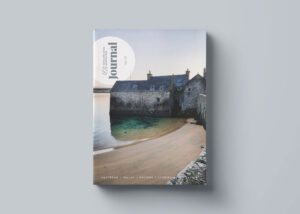by Hayley Anderton

My list of favourite books that are specifically about Shetland are an odd bunch, it’s a place that often crops up as part of a journey but is more rarely the sole focus. This starts with The Orkneyinga Saga. Written in the early 13th century when Shetland and Orkney were Norse possessions it really centers on Orkney which was undoubtedly the richer and more important of the two island groups. However it has an account of Mousa Broch being used as part of an elopement (the same episode is mentioned in Egil’s Saga too) and is an excellent place to start exploring Shetland’s Norse past from and it’s place in that world.
Sir Walter Scott’s The Pirate is not his best work, but for Scott it’s relatively short. Scott takes a bit of effort; he can be slow going and he likes to draw things out, quite deliberately I think, as a game with his reader to see how much we will put up with, so you have to be in the right mood and take your time with him. He’s also really important, both for how the novel develops and for how we still tend to view Scotland. In The Pirate it’s Shetland getting a Scott make over – the name Jarlshof is his coinage, and he talks at length about Norse heritage and customs.
The Pirate was published in 1822, after Scott visited Shetland in 1814 with Robert Stevenson, on a lighthouse tour. The pirate of the title is based on the real life Orkney scoundrel John Gow. If you can find a copy of his diary from the time (published as The Voyage of the Pharos, and as Northern Lights, but both currently out of print) it is particularly engaging. He’s often quoted in books about the Stevensons.
Edward Charlton’s Travels in Shetland 1832-52 fits in nicely here. It’s still available from The Shetland Times bookshop and is so far my favourite of the easily available historic accounts of travels in Shetland. Charlton was a 17 year old medical student on his first trip and obviously liked what he found. He sailed on the schooner Magnus Troil named after a character in The Pirate and newly built. This book covers three visits that he makes to Shetland in all; he’s an appreciative as well as curious traveller who’s good company and makes this book much more than a curiosity.
A bonus of Charlton’s book is that it’s illustrated by some of his watercolour sketches. It’s a tradition that the artist John T. Reid carried on in 1867 with his Art Rambles in Shetland. Reprinted copies of this are available but a better bet if you can find it is Mairi Hedderwick’s Shetland Rambles, A Sketching Tour. Hedderwick follows in Reid’s footsteps so you get both his engravings and her watercolours and sketches showing the same scenes. You also get Hedderwick’s commentary on what Reid was up to and her own Shetland experiences – it’s a charming combination.
For another artist’s impression of Shetland there is Norman Ackroyd’s A Shetland Notebook published by the RA. Ackroyd has been traveling around the coast for more than 40 years sketching and recording what he sees to turn into a series of etchings. His Shetland Notebook is a facsimile edition of his actual sketch book and is the most affordable way to get up close to his work. This is an impressionistic view of Shetland, with images jotted down quickly, often from the deck of a boat. He’s more interested in light, colour, and atmosphere here than in detail; I find this little book tremendously evocative.
The first books a lot of people will associate with Shetland are Ann Cleeves’s series – Shetland probably hasn’t seen as much murder since The Orkneyinga Saga was written. It seems unfair to pick one title out of the collection, not least because Cleeves has been a frequent enough visitor to Shetland to both know it well enough to do it justice on the page, but also to record the changes she’s observed over the years. The whole series is an excellent way of getting a sense of the place and the better you know Shetland, the more fun you can have guessing which places she’s taken inspiration from.
Marsali Taylor’s Shetland Sailing Mysteries are also worth checking out if crime is your thing. Taylor is a local author, and the boat her heroine sails is based on her own yacht. This series is still growing and lots of fun (full disclosure, Marsali Taylor was my English teacher at junior high and is responsible for introducing me to my favourite author of all time).
My favourite Shetland based thriller however is Eric Linklater’s The Dark of Summer. Linklater’s father was an Orkney man and he spent many years there. He was a prolific and well-regarded writer throughout his life, there have been occasional reprints of his work in the last decade or so, but it’s easier to find him in charity shops in old orange Penguin editions. The Dark of Summer is not one of his easiest to find books, although it is available print on demand from Bloomsbury, and secondhand copies are reasonably priced.
It’s a little bit old fashioned, but still an exciting read. The action starts in the Faroes during the second world war and ends sometime around Korea when the Hero returns to Shetland for fishing and Romance. Linklater covers a lot in this book including hinting at Operation Mincemeat in the form of a handily frozen corpse, the Shetland Bus, going over the story of the Giffords of Busta, and co opting in the Gunnister man. It’s a lot of fun.
David Howarth’s account of the Shetland Bus operation run from Scalloway and Lunna to help the Norwegian resistance is another book worth seeking out. The stories of the men involved and the things they endured are remarkable and this is another book well worth reading. It always surprises me that this isn’t a better known story, but it’s certainly at the root of the current close links between Shetland and Norway. Haworth’s account is a nice mix of cold fact and derring-do.
There are some really exciting writers linked to Shetland at the moment and I’m running out of space, but Malachy Tallack’s The Valley at the Centre of the World is particularly worthy of note. It’s his first novel, and it touches on a lot of issues about belonging and finding a place in contemporary Shetland. What makes this book so good is that the themes are universal to small close-knit rural communities and the issues around how incomers make a life in these places, and how locals reconcile tradition and nostalgia with modern life are really worth discussing.
I could write a whole post on contemporary Shetland poets, but right now the one to check out is Roseanne Watt. Her debut collection Moder Dy has won a lot of awards all of which it richly deserves. It’s a remarkable and exciting collection. Watt is interested in using dialect, but she does it in ways that feel slightly different to anything I’ve read before. It’s not just the way she uses dialect but her purposes for doing it, and the legends and folklore she explores at the same time. She’s incredibly gifted and very much one to watch.
A & A Christie Johnston’s Shetland Words dictionary is another favourite Shetland book. For a long time it sat on my shelf not doing very much – something bought because I felt I needed it, but who reads a dictionary? It came into its own when I was researching some place names and started looking up what certain things meant. The map I was looking at came alive with the understanding that place and croft names described the landscape they’re part of. Since then I’ve come to think of this book as indispensable.
This post would not be complete without my final book; all of the Shetland Guild of Spinners, Knitters, Weavers, and Dyers books have been excellent, all are worth having, but the first one they produced – A Legacy of Shetland Lace is particularly worthy of note. It’s not just for the patterns and the knitting know how, although the patterns are exquisite and the know how useful that make this book so special. It’s the way the individual knitters are centered, this book is a testament to the skill and generosity of generations of women. Their memories, knitting lore, and knitting language is gently explored so that even if you never knit a stitch you still have a treasure here.
Happy reading!
P.S. Have you ordered your copy of the brand new Shetland Wool Adventures Journal yet? The Journal will feature beautiful photography, knitting patterns, walks, interesting stories, interviews, recipes and some personal insights into the lives of the isles’ top knitters and craftspeople. These are just some of the delights awaiting you in this brand new publication. Shetland is a beautiful and inspiring place and the Journal aims to bring a little piece of our magical isles to your home.



Thank you. Other than Ann Cleeves, do you know of any other series. Ready to come and rent a cottage for a month.
Hello Sharon, renting a cottage for a month sounds lovely! Ann Cleeves has other crime fiction series but they are not based in Shetland. There is Vera and the latest one, The Long Call, is based in Devon I think. You might enjoy Marsali Taylor’s books.
I studied Old Norse at University, and ORKNEYINGA SAGA was one of our set texts!
Right now I am working through A LEGACY OF SHETLAND LACE, which I bought during one of my visits to Shetland Wool Week.
I have read all Marsali Taylor’s novels, all Anne Cleaves “Shetland” novels , The Valley at the centre of the world”, The Shetland bus I bought for
my husband and I have ordered your Shetland Wool Adventures Journal and am very excited to receive it. I agree that the Shetland book shop is a great shop to order from as orders arrive very promptly down to mainland Scotland. I will be checking out some of your other suggestions, many thanks and can’t wait to visit Shetland again, it does stay with you after you leave.
Thank you so much! I love reading books set in places I know. I’ve just ordered 2 books on your lust.
[…] mentioned A Legacy of Shetland Lace previously so I’m leaving it out this time (although it’s brilliant) and instead give you A […]
What do you think of the book and TV series Outlander? It’s not Shetland but close. It seems rather primitive and barbaric for 1743. I am curious to know about the extinction of Scottish Gaelic, tho that’s another topic.
What a lovely post. I’ve read The Shetland Bus as it’s part of my country’s history. And I’ve been to Lunna and Scalloway. A facinating true story. And I’vre read almost all of Ann Cleves books except Wild Fire. I’ve saved that one as I understood that was her last one with Jimmy Perez. I’ve also read one of Marsali Taylor but the rest of the authors are unknown to me. I look forward to read these books. I’ve also ordered the Shetland Wool Adventure Journal and I look forward to find it in my mail box. I love everything about Shetland as I feel like coming home to Norway when I’m visiting the islands.
The Sixteen Trees of the Somme by Lars Mitting begins in Norway but a large part of it is set on Unst and Mainland Shetland and as the title suggests, also links it to northern France. It even uses street names in Lerwick so as I was reading I could picture the setting.
It’s a brilliant read!
The Sixteen Trees of the Somme by Lars Mitting is a near masterpiece, set in a 1990s Shetland which has (barely) evolved from the 1950s without the societal revolution occasioned by the arrival of the oil industry and multiple (colour) TV channels and greater interaction with mainland Britain. It is currently my favourite “Shetland” book and I commend it to you.
This is a fabulous website, by the way. Well done Misa (and thank you too Hayley).
Thank you for recommending Sixteen Trees of the Somme. I thoroughly enjoyed the book.
I’ve read all of Marsali Taylor’s books and Anne Cleeves. Read the Shetland Bus many years ago while still at school. It might be worth rereading. I’ve downloaded the Dark of Summer and also ordered the Shetland Wool Adventures Journal so that should keep me out of mischief for a while.
[…] Shetland with Laurie blog 10 favourite books about Shetland […]
I am hoping to visit Shetland for a week, at least, in late February. I’m hoping I’ll be able to do lots of walking around, to see the islands, and also hoping to do a lot of knitting! I’m hoping the museums and some shops will be open, even if other sites are not.
That sounds lovely Leanna, I hope it works out for you. Winter walking is brilliant but make sure you take plenty layers as it can be bitterly cold!
Another book, The Sixteen Trees of the Somme by Lars Mytting. Set in Shetland and northern France. A wonderful read.